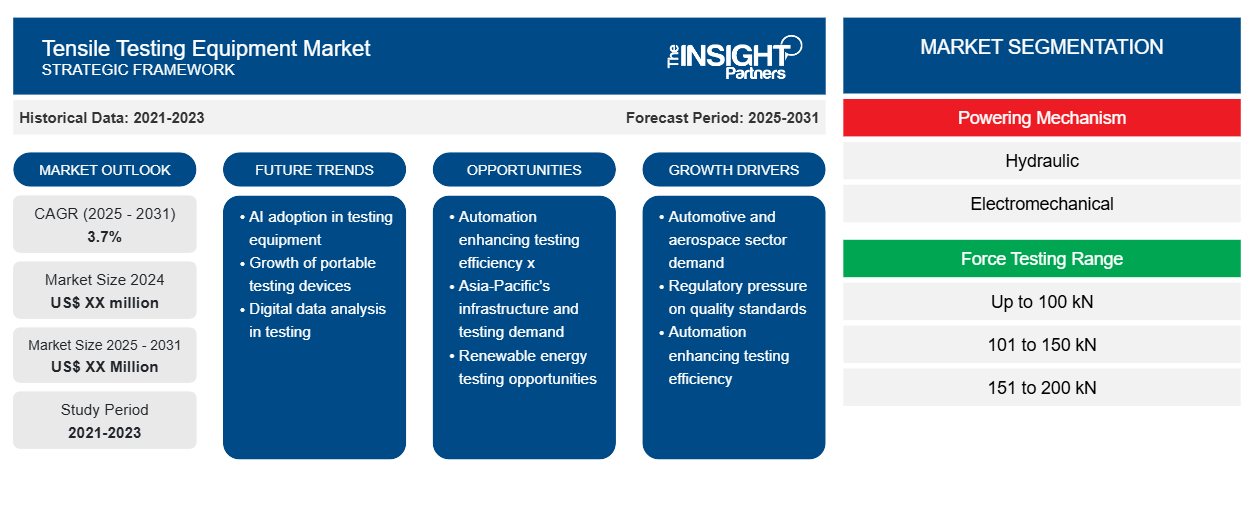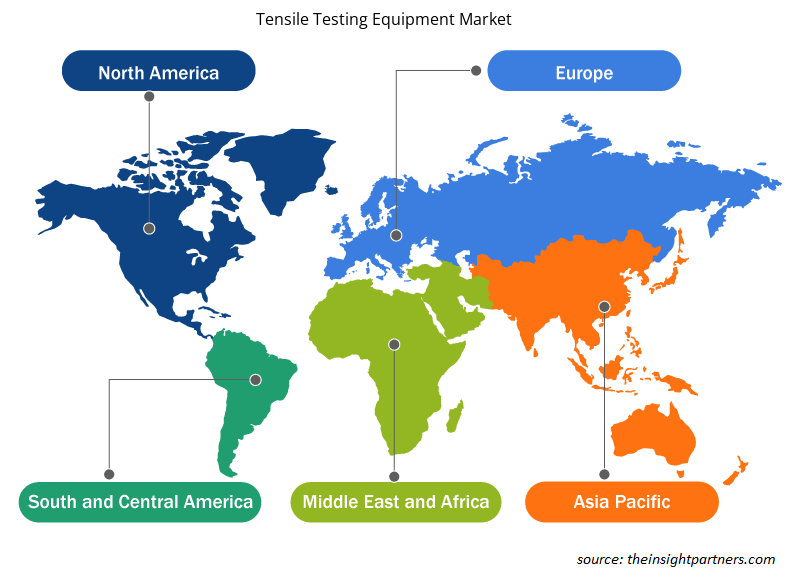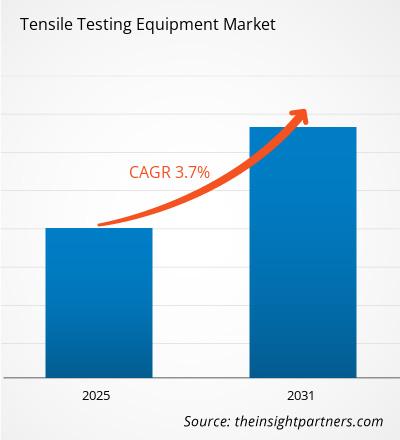The Tensile Testing Equipment Market is expected to register a CAGR of 3.7% from 2025 to 2031, with a market size expanding from US$ XX million in 2024 to US$ XX Million by 2031.
The Tensile Testing Equipment Market report covers analysis By Powering Mechanism, Force Testing Range; and End-users. The global analysis is further broken down at the regional level and major countries. The Report Offers the Value in USD for the above analysis and segments.
Purpose of the Report
The report Tensile Testing Equipment Market by The Insight Partners aims to describe the present landscape and future growth, top driving factors, challenges, and opportunities. This will provide insights to various business stakeholders, such as:
- Technology Providers/Manufacturers: To understand the evolving market dynamics and know the potential growth opportunities, enabling them to make informed strategic decisions.
- Investors: To conduct a comprehensive trend analysis regarding the market growth rate, market financial projections, and opportunities that exist across the value chain.
- Regulatory bodies: To regulate policies and police activities in the market with the aim of minimizing abuse, preserving investor trust and confidence, and upholding the integrity and stability of the market.
Tensile Testing Equipment Market Segmentation
Powering Mechanism
- Hydraulic
- Electromechanical
Force Testing Range
- Up to 100 kN
- 101 to 150 kN
- 151 to 200 kN
- Beyond 250 kN
End-users
- Materials and Packaging
- Automotive
- Manufacturing
- Aerospace and Defense
- Others
Geography
- North America
- Europe
- Asia-Pacific
- South and Central America
- Middle East and Africa
You will get customization on any report - free of charge - including parts of this report, or country-level analysis, Excel Data pack, as well as avail great offers and discounts for start-ups & universities
Tensile Testing Equipment Market: Strategic Insights

- Get Top Key Market Trends of this report.This FREE sample will include data analysis, ranging from market trends to estimates and forecasts.
Tensile Testing Equipment Market Growth Drivers
- Automotive and aerospace sector demand: Emerging demand from the automotive and aerospace sectors, which strongly require stringent material testing for a quality and safety assurance approach, is driving the tensile testing equipment market size. According to Tensile Testing Equipment Market reports, these industries rely on the tensile testing of metal and composite materials related to durability and strength assurance. Competitive analysis indicates a rise in demand for complex testing equipment as these markets grow, which further catapults the global market development and makes tensile testing an essential tool for building product reliability.
- Regulatory pressure on quality standards: This would be one of the important drivers in the tensile testing equipment market due to the heightened awareness of the quality and safety standards prevailing across industries. According to Tensile Testing Equipment Market trends, the government or regulatory bodies are implementing tighter regulations, thereby forcing companies to adopt more reliable testing techniques. This driver is strongly visible in consumer goods and construction sectors, as these industries are very material-intensive and strength is a factor of concern. According to PEST analysis, pressures from regulatory bodies and customers are driving the growth in this market because companies focus more on quality assurance and compliance through tensile testing.
- Automation enhancing testing efficiency: Automation and digital analysis of data have upgraded the features of tensile testing equipment to be more precise, accurate, and time-saving. Market research says that automation is a competitive advantage worldwide; it enables firms to perform tests with little deviation and at a greater velocity. These developments entice businesses that seek an elevated rate of throughput with superior quality control, hence supplementing the growth of the Tensile Testing Equipment Market size as testing equipment improves to cater to a vast array of material-testing application requirements.
Tensile Testing Equipment Market Future Trends
- AI adoption in testing equipment: The most apparent trend in the tensile testing equipment market is automation and AI adoption that enable faster and more accurate results from the test. During the SWOT analysis, it was realized that automation of the test would avoid human error, hence, enhancing operational efficiency and reliability. Presently, key players are adding AI-based solutions to their strategic plans for the market as the current demand for automated testing equipment from industries like manufacturing and construction is high. Market trends will likely continue adoption as the necessity for improved productivity and data accuracy increases.
- Growth of portable testing devices: Market trend shows the increase of portable tensile testing devices, thus enabling them to be handy for different industry sectors. Most producers are now using the introduction opportunity of very lightweight and portable, whose main aim is to carry out site testing. There is a market strategy that causes easy logistical convenience that is used in construction or aerospace companies where field test is taken to heart. Therefore, predictions on the markets predict a remarkable growth in the portable line.
- Digital data analysis in testing: Digital data analysis is becoming increasingly mainstream in the tensile testing equipment market, pushed in part by the rising emphasis that quality control places upon report generation in real-time. SWOT analysis provides several insights into how improved reporting systems can be achieved while utilizing digital integration to become increasingly efficient in testing efficiency on the part of a stream of industries. Key players are capitalizing on this trend through Tensile Testing Equipment Market strategies focusing on digitalized testing solutions and targeting industries that depend on data-driven insights. The market trends indicate that the demand for digital data solutions is going to drive market growth.
Tensile Testing Equipment Market Opportunities
- North America's market growth potential: The North American region is considered a significant growth opportunity in the tensile testing equipment market. A Tensile Testing Equipment Market overview depicts this region as having the most developed industrial base, with the most rigid regulatory standards, supporting equipment adoption. The industry landscape indicates the investment of the manufacturers of North America toward quality assurance, thus showing a potential growth opportunity in the tensile testing business. Strong market share in the region suggests that it remains a leading driver for demanding advanced testing equipment.
- Asia-Pacific's infrastructure and testing demand: This market is poised to grow within the Asia-Pacific region since it is witnessing a developing construction and infrastructure industry. With investments in large-scale infrastructure, the market share in the geography is also growing since the material being used will need to pass strict tests. Industry landscape analysis finds that construction companies in emerging economies are focusing on quality standards, which will enhance the demand for tensile testing. This growth opportunity signifies Asia-Pacific as a very significant region for Tensile Testing Equipment Market growth in testing equipment.
- Renewable energy testing opportunities: The renewable energy industry, mainly in Europe and North America, is opening new opportunities for tensile testing equipment as no stone is left unturned by renewable projects on material testing. Market research studies, in the overview, believe that testing equipment is always needed to check the wind, solar, and other renewable power installation's durability-proofing material. This is an emerging area of growth with renewable energy initiatives. Quality assurance of sustainable energy projects will always require absolute tensile testing equipment; this increases the Tensile Testing Equipment Market share for players in this industry.
Tensile Testing Equipment Market Regional Insights
The regional trends and factors influencing the Tensile Testing Equipment Market throughout the forecast period have been thoroughly explained by the analysts at The Insight Partners. This section also discusses Tensile Testing Equipment Market segments and geography across North America, Europe, Asia Pacific, Middle East and Africa, and South and Central America.

- Get the Regional Specific Data for Tensile Testing Equipment Market
Tensile Testing Equipment Market Report Scope
| Report Attribute | Details |
|---|---|
| Market size in 2024 | US$ XX million |
| Market Size by 2031 | US$ XX Million |
| Global CAGR (2025 - 2031) | 3.7% |
| Historical Data | 2021-2023 |
| Forecast period | 2025-2031 |
| Segments Covered |
By Powering Mechanism
|
| Regions and Countries Covered | North America
|
| Market leaders and key company profiles |
Tensile Testing Equipment Market Players Density: Understanding Its Impact on Business Dynamics
The Tensile Testing Equipment Market is growing rapidly, driven by increasing end-user demand due to factors such as evolving consumer preferences, technological advancements, and greater awareness of the product's benefits. As demand rises, businesses are expanding their offerings, innovating to meet consumer needs, and capitalizing on emerging trends, which further fuels market growth.
Market players density refers to the distribution of firms or companies operating within a particular market or industry. It indicates how many competitors (market players) are present in a given market space relative to its size or total market value.
Major Companies operating in the Tensile Testing Equipment Market are:
- ADMET, Inc.
- AMETEK. Inc.
- Com-Ten Industries
- KOKUSAI CO., LTD.
- Labthink
Disclaimer: The companies listed above are not ranked in any particular order.

- Get the Tensile Testing Equipment Market top key players overview
Key Selling Points
- Comprehensive Coverage: The report comprehensively covers the analysis of products, services, types, and end users of the Tensile Testing Equipment Market, providing a holistic landscape.
- Expert Analysis: The report is compiled based on the in-depth understanding of industry experts and analysts.
- Up-to-date Information: The report assures business relevance due to its coverage of recent information and data trends.
- Customization Options: This report can be customized to cater to specific client requirements and suit the business strategies aptly.
The research report on the Tensile Testing Equipment Market can, therefore, help spearhead the trail of decoding and understanding the industry scenario and growth prospects. Although there can be a few valid concerns, the overall benefits of this report tend to outweigh the disadvantages.
Frequently Asked Questions
What is the expected CAGR of the Tensile Testing Equipment Market?
The Tensile Testing Equipment Market is expected to register a CAGR of 3.7% from 2023-2031.
What are the driving factors impacting the Tensile Testing Equipment Market?
The major factors impacting the Tensile Testing Equipment Market are: Growth in Automotive and Aerospace Industries, Increasing Focus on Product Quality and Safety Standards, and Technological Advancements in Testing Equipment
What are the future trends in the Tensile Testing Equipment Market?
Key future trends in this market are - Growth in material testing industries, Increase in demand for quality assurance, Advancements in testing technologies
Which are the key players in the Tensile Testing Equipment Market?
Key companies of this market are: ADMET Inc, AMETEK Inc, Com Ten Industries, KOKUSAI CO LTD, Labthink Mecmesin, Qualitest International Inc, Shimadzu Corporation, TESTEX Textile Testing Instruments.
What are the deliverable formats of Tensile Testing Equipment Market report?
The report can be delivered in PDF/PPT format; we can also share excel dataset based on the request.
What are the options available for the customization of this report?
Some of the customization options available based on request are additional 3–5 company profiles and country-specific analysis of 3–5 countries of your choice. Customizations are to be requested/discussed before making final order confirmation, as our team would review the same and check the feasibility.
- Historical Analysis (2 Years), Base Year, Forecast (7 Years) with CAGR
- PEST and SWOT Analysis
- Market Size Value / Volume - Global, Regional, Country
- Industry and Competitive Landscape
- Excel Dataset
Testimonials
Reason to Buy
- Informed Decision-Making
- Understanding Market Dynamics
- Competitive Analysis
- Identifying Emerging Markets
- Customer Insights
- Market Forecasts
- Risk Mitigation
- Boosting Operational Efficiency
- Strategic Planning
- Investment Justification
- Tracking Industry Innovations
- Aligning with Regulatory Trends
Yes! We provide a free sample of the report, which includes Report Scope (Table of Contents), report structure, and selected insights to help you assess the value of the full report. Please click on the "Download Sample" button or contact us to receive your copy.
Absolutely — analyst assistance is part of the package. You can connect with our analyst post-purchase to clarify report insights, methodology or discuss how the findings apply to your business needs.
Once your order is successfully placed, you will receive a confirmation email along with your invoice.
• For published reports: You’ll receive access to the report within 4–6 working hours via a secured email sent to your email.
• For upcoming reports: Your order will be recorded as a pre-booking. Our team will share the estimated release date and keep you informed of any updates. As soon as the report is published, it will be delivered to your registered email.
We offer customization options to align the report with your specific objectives. Whether you need deeper insights into a particular region, industry segment, competitor analysis, or data cut, our research team can tailor the report accordingly. Please share your requirements with us, and we’ll be happy to provide a customized proposal or scope.
The report is available in either PDF format or as an Excel dataset, depending on the license you choose.
The PDF version provides the full analysis and visuals in a ready-to-read format. The Excel dataset includes all underlying data tables for easy manipulation and further analysis.
Please review the license options at checkout or contact us to confirm which formats are included with your purchase.
Our payment process is fully secure and PCI-DSS compliant.
We use trusted and encrypted payment gateways to ensure that all transactions are protected with industry-standard SSL encryption. Your payment details are never stored on our servers and are handled securely by certified third-party processors.
You can make your purchase with confidence, knowing your personal and financial information is safe with us.
Yes, we do offer special pricing for bulk purchases.
If you're interested in purchasing multiple reports, we’re happy to provide a customized bundle offer or volume-based discount tailored to your needs. Please contact our sales team with the list of reports you’re considering, and we’ll share a personalized quote.
Yes, absolutely.
Our team is available to help you make an informed decision. Whether you have questions about the report’s scope, methodology, customization options, or which license suits you best, we’re here to assist. Please reach out to us at sales@theinsightpartners.com, and one of our representatives will get in touch promptly.
Yes, a billing invoice will be automatically generated and sent to your registered email upon successful completion of your purchase.
If you need the invoice in a specific format or require additional details (such as company name, GST, or VAT information), feel free to contact us, and we’ll be happy to assist.
Yes, certainly.
If you encounter any difficulties accessing or receiving your report, our support team is ready to assist you. Simply reach out to us via email or live chat with your order information, and we’ll ensure the issue is resolved quickly so you can access your report without interruption.















The List of Companies
1. ADMET, Inc.
2. AMETEK. Inc.
3. Com-Ten Industries
4. KOKUSAI CO., LTD.
5. Labthink
6. Mecmesin
7. Qualitest International Inc
8. Shimadzu Corporation
9. TESTEX Textile Testing Instruments
10. TestResources, Inc.






 Get Free Sample For
Get Free Sample For